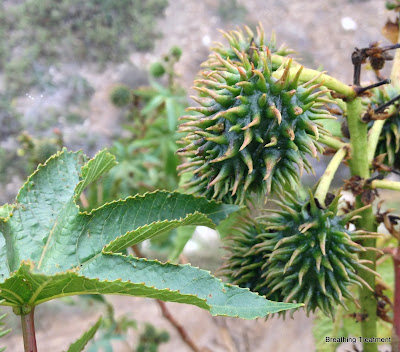I volunteer in a local canyon that is owned by a land conservancy. My charter is to survey invasive plants and I do so about once per month, hiking around and doing a little bit of wild gardening to encourage recovery of the local native plants. I wish I had more time to spend there, so I'm always looking for ways to multiply my efforts. I may have found an unwitting ally. Here's how:
Last month I noted in my report the the land conservancy that the castor beans (castor plant or Ricinus communis, a plant from eastern Africa that is considered invasive) were going to seed that that the small to medium sized plants were easy enough to pull from the loose, sandy, soil.
This month I returned to see that the conservancy had been working in the canyon while I was gone and had done extensive cutting of many invasive plants - mostly anise (Foeniculum), which had immature seeds. (By doing this work they were preventing the seeds from spreading further.)
I also noted that majority of the young castor bean plants were now dead.
I thought the conservancy had sprayed them with an herbicide. Not so.
Those root ends shown above have teeth marks! Gophers had eaten all the tender young roots. Who would think I'd be thankful for gophers?
A pattern began to emerge from which I drew the following conclusion: Mature castor plants (often near rock outcrops) were surviving only because the roots were not accessible to gophers. All the younger plants in the area were dead. This suggests that the most effective strategy for dealing with castor plants in this area is to eliminate the mature ones and let the gophers have the rest.



Gophers are like the Goat herds of the underground world.
ReplyDeleteI'll have a post later about Mountain Beavers. Most folks have never heard of them, but they look very much like a gopher on steroids in moister habitats.
There's so much kool stuff out there!
.